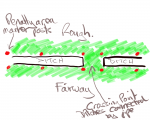backwoodsman
Tour Winner
Some of our fairways have lateral ditches running along their length. Marked as red penalty areas by red stakes - with no other markings. Occasionally, there are crossing points for tractors, mowers, machinery etc? (A long way round otherwise). The crossing points are not actual bridges - the ditch is filled, and grassed, level with either side. The two sections of ditch are connected by underground pipe. The attached image shows the layout on the ground.
In the absence of me providing any other information, is a ball lying on the crossing point inside, or outside the penalty area? And if a ball goes in the ditch and then into & half way through the connecting pipe, is that in or outside the PA?

In the absence of me providing any other information, is a ball lying on the crossing point inside, or outside the penalty area? And if a ball goes in the ditch and then into & half way through the connecting pipe, is that in or outside the PA?
